Coin Rarities & Related Topics: News and Analysis regarding scarce coins, coin markets, and the coin collecting community #267
A Weekly CoinWeek Column by Greg Reynolds
Among major, ‘live’ coin auctions, smaller events with relatively modest offerings tend to draw more attention to coins that are not extremely expensive. In large events, six-figure coins often overshadow less costly items. The single ‘live’ session of the official auction of the Winter ANA convention, by Stack’s-Bowers, contains 549 lots. While viewing a large portion of these lots in New York last week, an assortment of classic U.S. silver coins captured my attention, though some other coins in this sale are more valuable.
This one ‘live’ session will be conducted at the Oregon Convention Center in Portland, on March 6, starting at 6:00 PM Pacific Time. The ANA Convention itself will be open to the public from Thursday, March 5 to Saturday, March 7. A discount coupon is available at www.money.org. The bourse area will be the center of attention, though educational seminars are featured. On Tuesday, March 10, Stack’s-Bowers will offer another 441 lots in an “Internet Only” session. All 990 lots, or nearly all, are available for viewing at this convention center.
While a coin auction of just two sessions, without any Great Rarities or amazing sets, will not become an epic event in the history of coin collecting, some of the coins offered are important to many collectors. In the coin related media, there is often considerable coverage of auctions that total tens of millions of dollars and/or contain thousands of lots. Smaller coin auctions matter, too, and are meaningful to thousands of collectors.
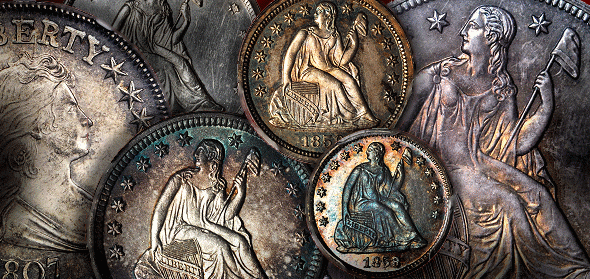
General Commentary about Auctions
A $10 million coin auction is not necessarily more successful than a $2 million coin auction. If a $2 million auction is characterized by frenzied bidding and battles for many coins that appeal to energized collectors, the prices realized in a small auction could be much stronger than the prices would have been, if a much larger auction had been conducted at the same place and time, by the same firm.
Additionally, it does not make sense to assume that coins that are more expensive are either more desirable or more important than coins that are less expensive. Coins that are relatively more expensive are sometimes unattractive, overgraded in the views of many experts, doctored, or expensive because coins of the same issue have been heavily promoted by telemarketers. It should never be assumed that a very expensive coin is a great coin or a rare one.
The offering of a regular High Relief 1907 Saint Gaudens Double Eagle ($20 gold coin), for example, is not usually newsworthy, despite the fact that almost all such coins retail for more than $20,000 each. There exist more than ten thousand of them and almost every major auction has at least one. Indeed, there are more than a half-dozen in some auctions.
These have been relentlessly telemarketed to non-collectors, for decades. I will not discuss the NGC graded MS-64, 1907 regular High Relief Saint, with a “Wire Rim,” in this event. Besides, all 549 lots in the ‘live’ session cannot be covered here. Emphasis here is on noteworthy, classic U.S. silver coins, especially those that commanded attention during lot viewing sessions in New York. Although there are terrific coins in this coin auction that are not mentioned here, some of the coins not mentioned were excluded for reasons best left unsaid.
In some cases, I just report PCGS or NGC grades of coins and am not necessarily agreeing with such grades. I recommend that each interested collector, who plans to spend a sum that he or she regards as ‘a lot,’ hire an expert consultant to carefully examine auction lots.
Half Dimes
The 1795 Flowing Hair half dime in this auction is NGC graded Extremely Fine-40. This is not a great representative of an early U.S. coin, though it is pleasing enough. The mint-caused imperfections on the face are a little distracting, yet are much less serious, in my view, than deliberate modifications of a coin after it left the mint or noticeable consequences of environmental damage. This coin seems to have fared well during a period of almost 220 years, and it is of a two-year type. The toning is natural and the surface quality is well above average for a pre-1800 U.S. silver coin.
In this auction, there is an 1834 Capped Bust half dime of an unusual, though not rare, variety; a numeral ‘3’ was over-struck over an inverted ‘3’ that was struck in the obverse die (which was used to stamp the front of the coin) by mistake. This dime is NGC graded “MS-66+.”
Although I place the grade of this coin in the middle, not the high end, of the 66 range, I understand the likely thinking, in regards to this half dime, of the graders at NGC. After all, this 1834 half dime is sharply struck, semi-prooflike, and very cool. Die striations (or ‘striae’) are lines in the dies that bring about raised lines on the coin. These cause this coin to curiously glitter when tilted under a lamp. It is one of the more exciting coins in this auction.
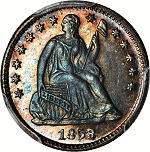 Although I just glanced at the 1847 Liberty Seated half dime in this sale, it seemed to be naturally toned and very attractive. It is NGC graded MS-65 and is a significant condition rarity in the gem quality range, 65 and higher grades.
Although I just glanced at the 1847 Liberty Seated half dime in this sale, it seemed to be naturally toned and very attractive. It is NGC graded MS-65 and is a significant condition rarity in the gem quality range, 65 and higher grades.
One of my favorite coins in the sale is a Proof 1858 half dime. It is PCGS graded Proof-65 and CAC approved. The natural toning is terrific. The reverse (back) is very attractive and the obverse (front) is even more attractive. The greenish blue Miss Liberty contrasts well with the brown-russet inner fields.
Unlike some Proof half dimes from the 1850s that are certified as Proofs, this one certainly is so. The relationships of the dentils to the rims and the rims to the edge provide evidence, among other pieces of evidence, of a method of manufacture that is distinct from the way in which business strikes were made. The fact that this coin was struck twice is especially pertinent.
The 1858 business strike in this sale, which is from a different consignment, has great natural toning, too. I enjoyed viewing it. As for whether it deserves its grade of “MS-66+,” I would have to examine it again before commenting.
There is no doubt about the fact that the 1869 half dime in the following lot does and should grade MS-66. This 1869 half dime is more than very attractive and has minimal imperfections. This is a coin that is much more appealing in actuality than it appears to be in images. It is PCGS certified as Proof-66 and is CAC approved.
Dimes
The first dime in the sale that really stands out is an 1849 that is NGC graded MS-66. It is very attractive, very original, and technically impressive. Though finding a circulated 1849 is not difficult, these are important condition rarities in the gem range.
 The coin in the next lot, a Proof 1859 dime, is very likable. It is PCGS certified as ‘Proof-65 Cameo.’ This is of the last year of the ‘stars on obverse’ design type. The legend, ‘UNITED STATES OF AMERICA, was moved to the obverse design in 1860.
The coin in the next lot, a Proof 1859 dime, is very likable. It is PCGS certified as ‘Proof-65 Cameo.’ This is of the last year of the ‘stars on obverse’ design type. The legend, ‘UNITED STATES OF AMERICA, was moved to the obverse design in 1860.
The 1860 business strike in this sale has toning that is stable, mellow and neat. Tan, russet, and blue hues blend with touches of green. This coin is NGC graded MS-66.
A NGC graded MS-67, 1910-S Barber Dime is more than very attractive and does not exhibit any significant contact marks. It would be interesting to learn if the leading bidders value this coin at or near the same price level as the two that have been PCGS graded MS-67.
One of the two PCGS graded MS-67 1910-S Barber dimes was auctioned by HA for $20,700 in Feb. 2007. The other, the Simpson coin, was just auctioned by Legend last month for $21,150. The 1910-S in this auction is superior to the NGC graded MS-67 1910-S in the Gene Gardner Collection, which realized $7343.75 in June 2014, though the Gardner piece has more appealing toning.
Twenty Cent pieces
The 1875 Philadelphia Mint Twenty Cent piece in this session is NGC certified as Proof-65. It has full mirrors and entertaining layers of natural toning. This 1875 is one of the most colorful and pleasing coins in the sale.
The 1875-CC is this auction is clearly non-gradable, though is appealing for a non-gradable coin. I have seen many non-gradable 19th century silver coins that are in far worse condition.
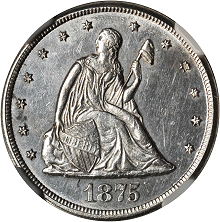 The NGC holder indicates that this 1875-CC was ‘improperly cleaned.’ Although it may have been harmed by some nasty chemicals, there is no indication of any gashes, culls, dents, or severe scratches. While the holder indicates ‘Unc. Details,’ the coin has some readily noticeable friction, which could be due to mishandling rather than circulation in commerce. It should sell for a price that is much lower than the market values of AU-55 to MS-61 grade 1875-CC Twenty Cent pieces.
The NGC holder indicates that this 1875-CC was ‘improperly cleaned.’ Although it may have been harmed by some nasty chemicals, there is no indication of any gashes, culls, dents, or severe scratches. While the holder indicates ‘Unc. Details,’ the coin has some readily noticeable friction, which could be due to mishandling rather than circulation in commerce. It should sell for a price that is much lower than the market values of AU-55 to MS-61 grade 1875-CC Twenty Cent pieces.
As 1876-CC Twenty Cent pieces are Great Rarities, 1875-CC coins are the only Carson City, Nevada Mint Twenty Cent pieces that tens of thousands of collectors can afford. As there are many non-gradable coins that have been mistakenly assigned numerical grades by PCGS and NGC, anyway, coins in ‘Genuine’ or ‘Details’ holders may sometimes be good values.
The reasons why particular coins are judged non-gradable vary, and the severity of serious problems varies even more so. It is more difficult to estimate market values of coins in ‘Details’ holders than it is to estimate the market values of corresponding coins that are clearly gradable.
Quarters
Of all the quarters in this session, the first that I found to be especially impressive was the 1842-O ‘Large Date’ Liberty Seated quarter. The NGC grade of AU-58 could not be controversial; this coin has just a little friction.
Yes, it is true that there are imperfections noticeable on Miss Liberty and in the obverse inner fields, some of which are mint-caused. On the PCGS CoinFacts site, similar or analogous imperfections may be seen in the same vicinities on the high resolution images of each of three, PCGS graded MS-64, 1842-O ‘Large Date’ quarters, particularly on the one that HA sold in April 2013.
Of course, I am not arguing that the 1842-O in this auction merits a grade of MS-64, and I am not encouraging anyone to ‘crack it out’ of its current NGC holder. Because it has more such imperfections in quantity and magnitude than most higher grade quarters of this date, and because of the already mentioned friction on the highpoints, AU-58 is an appropriate grade for the 1842-O quarter in this auction.
This 1842-O ‘Large Date’ has a neat overall appearance. There are blue tones in the outer fields. Medium russet-gray tones tend to dominate and green tinted areas are memorable.
As it is readily apparent that the numerals of the date are noticeably larger than the numerals are on the 1842-O ‘Small Date,’ both varieties are often collected as if they are dates distinct from each other. Put differently, someone who collects Liberty Seated quarters ‘by date’ (and mint location) will typically seek both an 1842-O ‘Large Date’ and an 1842-O ‘Small Date.’
 The 1858-O is rare in all grades and the coin in this sale is a major condition rarity. Indeed, these are extremely rare in 63 and higher grades, the ‘choice uncirculated’ range. PCGS has graded two as MS-63, one as MS-64 and one as MS-64+. NGC reports having graded zero as MS-63, one as MS-63+, zero in the 64 range and one as MS-65. The combined total of six may represent fewer than six different coins.
The 1858-O is rare in all grades and the coin in this sale is a major condition rarity. Indeed, these are extremely rare in 63 and higher grades, the ‘choice uncirculated’ range. PCGS has graded two as MS-63, one as MS-64 and one as MS-64+. NGC reports having graded zero as MS-63, one as MS-63+, zero in the 64 range and one as MS-65. The combined total of six may represent fewer than six different coins.
The NGC graded “MS-63+” 1858-O is in this auction. It was dipped within the last forty years and has naturally retoned in a pleasing manner. This coin is more than attractive. The retail value for this coin should be at least $8700. A much higher price would not be surprising.
In an article on the Battle Born 1870-CC quarter, I noted, “As 1873-CC ‘No Arrows’ Quarters are Great Rarities, and 1871-CC quarters are even rarer than 1870-CC quarters, the 1870-CC is not discussed as often as some of her sisters. Of the 110 to 155 that survive, a substantial percentage, maybe half of them, are not gradable, meaning these have problems that are too serious for them to merit numerical grades. Many collectors shun or ignore coins that are not gradable, though others find them to be good values.”
The 1870-CC quarter in this auction was determined by experts at NGC to have been ‘improperly cleaned’ on the reverse (back) and to have the ‘details’ of an AU grade coin. Even so, it has appealing natural toning and is a half-decent coin. It is relatively more original than the already mentioned, non-gradable 1875-CC Twenty Cent piece, which is a desirable coin. This 1870-CC quarter would fit well enough into a set of EF-40 to MS-60 Liberty Seated quarters and should be much less expensive than a PCGS or NGC certified AU-50 or EF-45 1870-CC.
Almost a year ago, HA sold an NGC graded EF-40 1870-CC for $32,900. Two months earlier, an NGC graded AU-53 1870-CC brought $70,500. For some relevant collectors who cannot afford such an 1870-CC, the presently offered coin might be a very desirable alternative.
Half Dollars
There is a 1794 half in this auction with a noticeable hole. I have always found coins with open holes to be more honest than those that have been plugged, as the plugging processes are often intended to deceive people. It is better to leave the hole open and to regard it as part of the history of the coin. As it is unlikely that anyone would have drilled a hole in a 1794 half over the past eighty years, someone used it as a decorative object in some past era, probably in the middle of the 19th century.
A Fine-12 grade 1794 half has a retail value of around $14,000 and would be likely to realize at least $10,000 at auction. One with a hole will bring considerably less and may be a good value for someone assembling a set of half dollars. After all, 1794 is the first year of the denomination and this is a genuine representative.
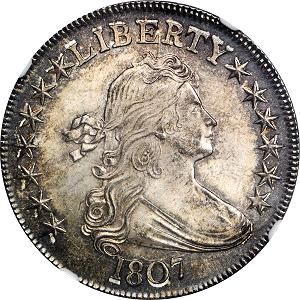 Though not as famous as the Flowing Hair halves of 1794-95, Draped Bust, Heraldic Eagle halves are scarcer than most collectors realize. The 1807 is the last year of type and is one of the least scarce dates of the Draped Bust, Heraldic Eagle half dollar type, though all coins of this type are condition rarities in grades above 63.
Though not as famous as the Flowing Hair halves of 1794-95, Draped Bust, Heraldic Eagle halves are scarcer than most collectors realize. The 1807 is the last year of type and is one of the least scarce dates of the Draped Bust, Heraldic Eagle half dollar type, though all coins of this type are condition rarities in grades above 63.
The NGC graded MS-65 1807 in this auction is an extremely important type coin. It is technically impressive, with minimal marks and no readily apparent hairlines. After having been lightly dipped long ago, it has naturally retoned in an attractive manner.
The four 1839-O Gobrecht ‘Reeded Edge’ halves that are NGC certified as ‘Proofs’ are complicated and should be discussed in a separate setting. The one in this auction is the highest graded, 65. HA sold this same coin, in the same holder, during February 2012 for $299,000.
A colorfully toned 1916-D Walking Liberty Half Dollar (Walker) is NGC certified as “MS-66*.” The 1916-S is an even better date than the 1916-D. The NGC graded MS-63 1916-S in this auction, at a glance, seemed to be very appealing.
While I just briefly viewed the two NGC graded MS-64 1918-S Walkers, interested bidders or their respective agents may wish to scrutinize them. As a MS-65 grade 1918-S is so much more costly than a MS-64 grade 1918-S, certified MS-64 1918-S halves are demanded by many collectors who are assembling choice to gem ‘mint state’ sets of Walkers.
Proof 1845 Silver Dollar
As the catalogue notes, this PCGS certified Proof-65 1845 dollar had been offered at auction during 2009, 2010, and 2011. The current offering thus marks at least the fourth time that this coin has been ‘on the market’ during a period of less than six years. I am puzzled as to why it has not found a long-term home. This is a great coin.
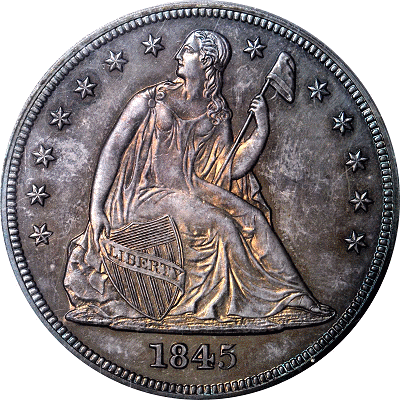 My notes in 2015 were very consistent with my notes in 2011. Its Proof status is indisputable. The colorful tones are natural and blend together well. The shades of russet, blue, apricot, tan and green are pleasing. Miss Liberty and the reverse eagle were each frosted-white when this coin was struck and still contrast nicely with the fields.
My notes in 2015 were very consistent with my notes in 2011. Its Proof status is indisputable. The colorful tones are natural and blend together well. The shades of russet, blue, apricot, tan and green are pleasing. Miss Liberty and the reverse eagle were each frosted-white when this coin was struck and still contrast nicely with the fields.
It might be true that the consignor of this coin to a past auction attached a poorly reasoned reserve. Apparently, there is no reserve on this coin this week. It would be an excellent addition to a type set of Liberty Seated coins.
One reason why pioneer gold coins in this auction are not being discussed here is that these require much addition explanation. As this auction is in Portland, however, it is appropriate that an 1849 Oregon pioneer $5 gold coin is included. This Oregon five is PCGS graded “VF-35.” As the grading and overall interpretation of these are particularly complicated, it is not practical to analyze this coin here. Oregon gold coins are rare and historically important.
As the Winter ANA Convention is so much smaller than the Summer ANA Convention, no one expects a mammoth auction. Besides, there are large auctions on the docket. Later this month, Stack’s-Bowers will soon auction the epic Kendall Collection in Baltimore.
In April, HA will conduct a very large auction at the Central States Convention in Illinois. On May 12, the third installment of the epic Gene Gardner Collection will be sold in New York.
One week later, Stack’s-Bowers will conduct the first sale of the Pogue Family Collection of early U.S. coins, which will probably be followed, a day later, by a Rarities Night event featuring consignments from other sources. I look forward to covering these events.
©2015 Greg Reynolds




